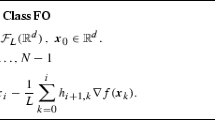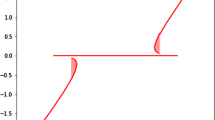Abstract
This paper considers the numerical solution of optimal control problems involving a functionalI subject to differential constraints, nondifferential constraints, and terminal constraints. The problem is to find the statex(t), the controlu(t), and the parameter π so that the functional is minimized, while the constraints are satisfied to a predetermined accuracy.
The approach taken is a sequence of two-phase processes or cycles, composed of a gradient phase and a restoration phase. The gradient phase involves a single iteration and is designed to decrease the functional, while the constraints are satisfied to first order. The restoration phase involves one or several iterations and is designed to restore the constraints to a predetermined accuracy, while the norm of the variations of the control and the parameter is minimized.
The principal property of the algorithm is that it produces a sequence of feasible suboptimal solutions: the functionsx(t),u(t), π obtained at the end of each cycle satisfy the constraints to a predetermined accuracy. Therefore, the functionals of any two elements of the sequence are comparable.
The stepsize of the gradient phase is determined by a one-dimensional search on the augmented functionalJ, and the stepsize of the restoration phase by a one-dimensional search on the constraint errorP. If α g is the gradient stepsize and α r is the restoration stepsize, the gradient corrections are ofO(α g ) and the restoration corrections are ofO(α r α g 2). Therefore, for α g sufficiently small, the restoration phase preserves the descent property of the gradient phase: the functionalÎ at the end of any complete gradient-restoration cycle is smaller than the functionalI at the beginning of the cycle.
To facilitate the numerical solution on digital computers, the actual time ϑ is replaced by the normalized timet, defined in such a way that the extremal arc has a normalized time length Δt=1. In this way, variable-time terminal conditions are transformed into fixed-time terminal conditions. The actual time τ at which the terminal boundary is reached is regarded to be a component of the parameter π being optimized.
The present general formulation differs from that of Ref. 4 because of the inclusion of the nondifferential constraints to be satisfied everywhere over the interval 0 ≤t ≤ 1. Its importance lies in that (i) many optimization problems arise directly in the form considered here, (ii) problems involving state equality constraints can be reduced to the present scheme through suitable transformations, and (iii) problems involving inequality constraints can be reduced to the present scheme through suitable transformations. The latter statement applies, for instance, to the following situations: (a) problems with bounded control, (b) problems with bounded state, (c) problems with bounded time rate of change of the state, and (d) problems where some bound is imposed on an arbitrarily prescribed function of the parameter, the control, the state, and the time rate of change of the state.
Numerical examples are presented for both the fixed-final-time case and the free-final-time case. These examples demonstrate the feasibility as well as the rapidity of convergence of the technique developed in this paper.
Similar content being viewed by others
References
Miele, A., Damoulakis, J. N., andCloutier, J. R.,Sequential Gradient-Restoration Algorithm for Optimal Control Problems with Nondifferential Constraints, Part 1, Theory, Rice University, Aero-Astronautics Report No. 109, 1973.
Miele, A., Tietze, J. L., andCloutier, J. R.,Sequential Gradient-Restoration Algorithm for Optimal Control Problems with Nondifferential Constraints, Part 2, Examples, Rice University, Aero-Astronautics Report No. 110, 1973.
Miele, A., Damoulakis, J. N., andTietze, J. L.,Sequential Gradient-Restoration Algorithm for Optimal Control Problems with Nondifferential Constraints, Part 3, Examples, Rice University, Aero-Astronautics Report No. 111, 1973.
Miele, A., Pritchard, R. E., andDamoulakis, J. N.,Sequential Gradient-Restoration Algorithm for Optimal Control Problems, Journal of Optimization Theory and Applications, Vol. 5, No. 4, 1970.
Rovner, J. M.,Optimization of Cyclic Parallel Reactors with Decaying Catalyst, Rice University, Department of Chemical Engineering, Ph.D. Thesis, 1973.
Jacobson, D. H., andLele, M. M.,A Transformation Technique for Optimal Control Problems with a State Variable Inequality Constraint, IEEE Transactions on Automatic Control, Vol. AC-14, No. 5, 1969.
Kelley, H. J.,Method of Gradients, Optimization Techniques, Edited by G. Leitmann, Academic Press, New York, New York, 1962.
Bryson, A. E., Jr., andDenham, W. F.,A Steepest-Ascent Method for Solving Optimum Programming Problems, Journal of Applied Mechanics, Vol. 84, No. 2, 1962.
Bliss, G. A.,Lectures on the Calculus of Variations, The University of Chicago Press, Chicago, Illinois, 1946.
Hestenes, M. R.,Calculus of Variations and Optimal Control Theory, John Wiley and Sons, New York, New York, 1966.
Pontryagin, L. S., Boltyanskii, V. G., Gamkrelidze, R. V., andMishchenko, E. F.,The Mathematical Theory of Optimal Processes, John Wiley and Sons (Interscience Publishers), New York, New York, 1962.
Bryson, A. E., Jr., andHo, Y. C.,Applied Optimal Control, Blaisdell Publishing Company, Waltham, Massachusetts, 1969.
Miele, A., Editor,Theory of Optimum Aerodynamic Shapes, Academic Press, New York, New York, 1965.
Miele, A.,Method of Particular Solutions for Linear, Two-Point Boundary-Value Problems, Journal of Optimization Theory and Applications, Vol. 2, No. 4, 1968.
Heideman, J. C.,Use of the Method of Particular Solutions in Nonlinear, Two-Point Boundary-Value Problems, Journal of Optimization Theory and Applications, Vol. 2, No. 6, 1968.
Miele, A., andIyer, R. R.,General Technique for Solving Nonlinear, Two-Point Boundary-Value Problems via the Method of Particular Solutions, Journal of Optimization Theory and Applications, Vol. 5, No. 5, 1970.
Miele, A., andIyer, R. R.,Modified Quasilinearization Method for Solving Nonlinear, Two-Point Boundary-Value Problems, Journal of Mathematical Analysis and Applications, Vol. 36, No. 3, 1971.
Ralston, A.,Numerical Integration Methods for the Solution of Ordinary Differential Equations, Mathematical Methods for Digital Computers, Vol. 1, Edited by A. Ralston and H. S. Wilf, John Wiley and Sons, New York, New York, 1960.
Miele, A., Mangiavacchi, A., andAggarwal, A. K.,Modified Quasilinearization Algorithm for Optimal Control Problems with Nondifferential Constraints, Part 1, Theory, Rice University, Aero-Astronautics Report No. 112, 1973.
Miele, A., Mangiavacchi, A., andAggarwal, A. K.,Modified Quasilinearization Algorithm for Optimal Control Problems with Nondifferential Constraints, Part 2, Examples, Rice University, Aero-Astronautics Report No. 113, 1973.
Damoulakis, J. N.,Gradient Methods in Control Theory, Part 3, Sequential Gradient-Restoration Algorithm: Numerical Examples, Rice University, Aero-Astronautics Report No. 65, 1969.
Hennig, G. R., andMiele, A.,Sequential Gradient-Restoration Algorithm for Optimal Control Problems with Bounded State Variables, Part I, Theory, Rice University, Aero-Astronautics Report No. 101, 1972.
Hennig, G. R., andMiele, A.,Sequential Gradient-Restoration Algorithm for Optimal Control Problems with Bounded State Variables, Part 2, Examples, Rice University, Aero-Astronautics Report No. 102, 1972.
Author information
Authors and Affiliations
Additional information
This research was supported by the Office of Scientific Research, Office of Aerospace Research, United States Air Force, Grant No. AF-AFOSR-72-2185. The authors are indebted to Dr. A. V. Levy for helpful discussions. This paper is a condensation of the investigations reported in Refs. 1–3. Portions of this paper were presented by the senior author at the 5th LFIP Conference on Optimization Techniques, Rome, Italy. 1973.
On leave from the US Naval Weapons Laboratory, Dahlgren, Virginia.
Rights and permissions
About this article
Cite this article
Miele, A., Damoulakis, J.N., Cloutier, J.R. et al. Sequential gradient-restoration algorithm for optimal control problems with nondifferential constraints. J Optim Theory Appl 13, 218–255 (1974). https://doi.org/10.1007/BF00935541
Issue Date:
DOI: https://doi.org/10.1007/BF00935541




